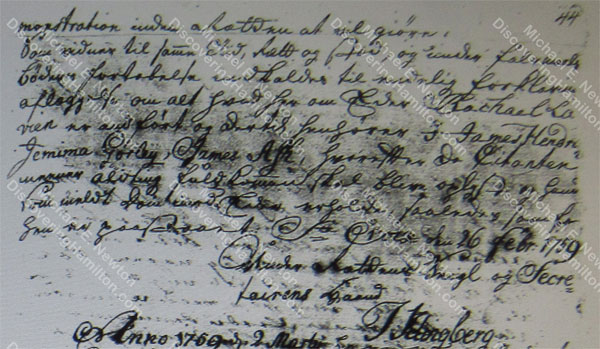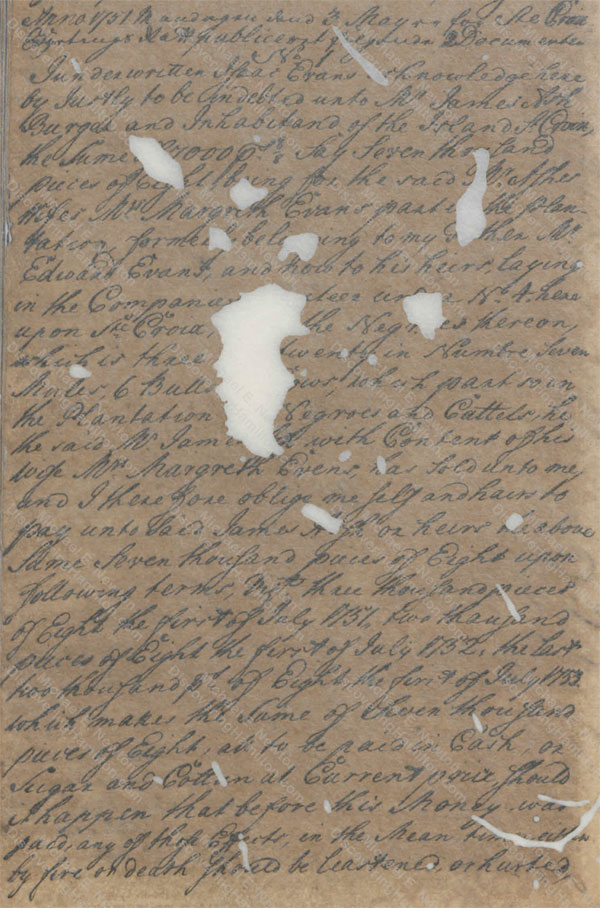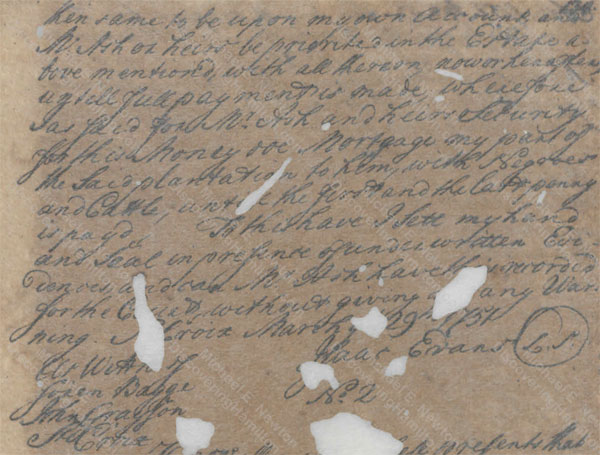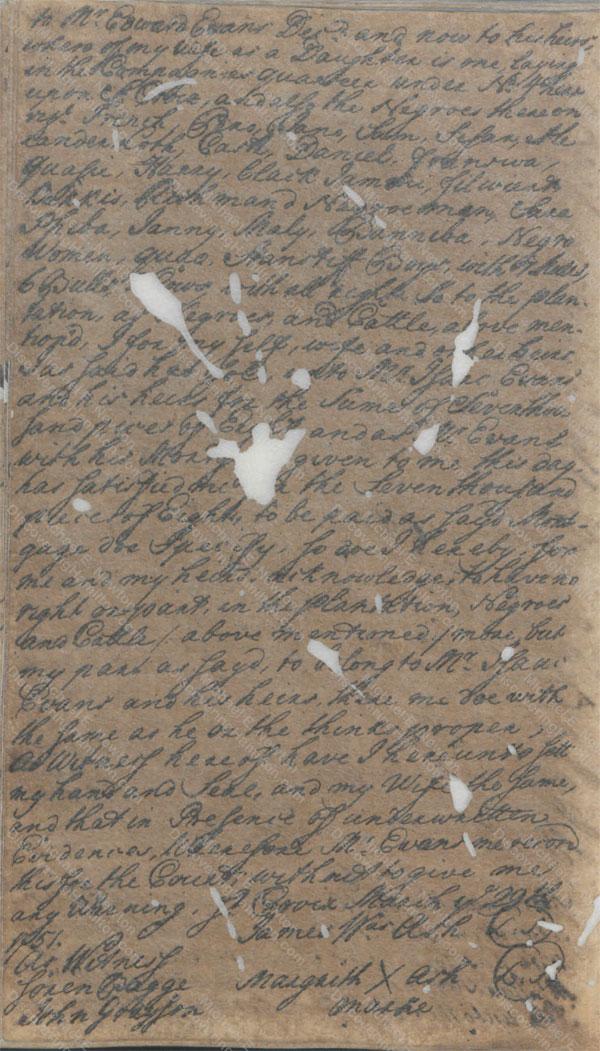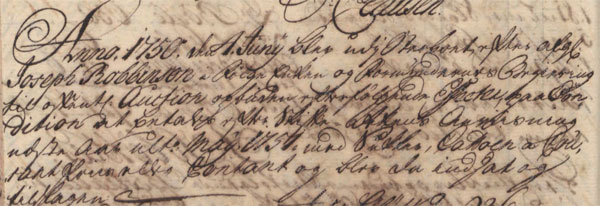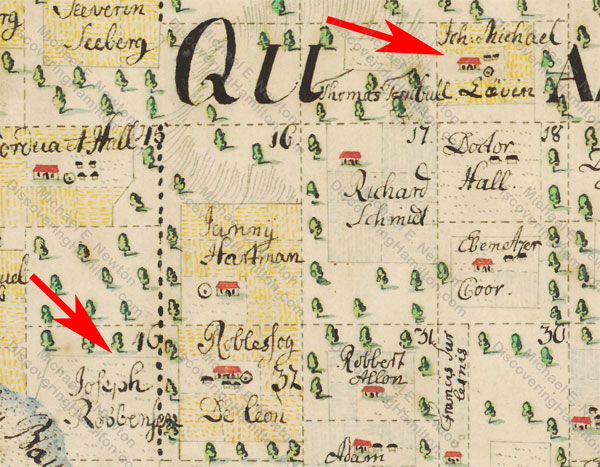Much of the information in this blog (and in all previous Hamilton bios) has been updated, expanded, or even corrected in Michael E. Newton's new book Discovering Hamilton. Please check that book before using or repeating any information you read here on this blog (or that you read in previous Hamilton biographies).
Two weeks ago, regarding the 1759 divorce of John Michael Lavien from Rachel Faucett Lavien (Hamilton), I wrote, “In addition to calling for Rachel to appear, the court summoned three other people to serve as witnesses: James Hendrie, Jemima Gorley, and James Ash.”
It will be recalled that H. U. Ramsing wrote, “The witnesses who were summoned were all living on St. Croix… They were all people of small means who owned few or no slaves.”[1]
It will also be recalled that based on this, Broadus Mitchell wrote of the witnesses, “Ramsing identified them as persons of no special note; they do not otherwise figure in the records of Rachael.”[2]
In that blog post of two weeks ago, we saw how “Jemima Gorley” was none other than Jemima Faucett Iles Gurley, the sister of Rachel Faucett. Seeing how one of the summoned witnesses was closely connected to the divorcing couple, one wonders if and how the others called to testify were related to them or to the events that instigated the divorce.
In this two-part series, we will investigate James Ash[3] and see if and how he was connected to John Michael Lavien and Rachel Faucett. (Hopefully we’ll investigate James Hendrie in the future.)
James Ash Marries Margaret Evans
In 1749, in the Dutch Reformed Church of St. Croix, James Ash married a Margarita (or Margaret) Evans.[4]
Isaac Evans Acquires James and Margaret Ash’s Share of Edward Evans’s Plantation
A couple of legal records gives us some more information regarding Margaret Evans’s identity.
On March 29, 1751, Isaac Evans made out a mortgage to “Mr. James Ash, Burger and Inhabitant of the Island of St. Croix,” for the sum of 7,000 pieces of eight for “Mr. Ash’s wife Mrs. Margreth Evans part in the plantation formerly belonging to my father Mr. Edward Evans,” i.e., No. 4 Company’s Quarter, including all the slaves and cattle, which “Mr. James Ash with consent of his wife Mrs. Margreth Evens has sold unto me” for “the above same seven thousand pieces of eight” to be paid in installments over the following two years.
On that same date, James Ash made out a deed to Isaac Evans for the above property. “I…James Ash with consent of my wife has sold…unto Mr. Isaac Evans and his heirs all my rights and title unto the plantation formerly belonging to Mr. Edward Evans Decd and now to his heirs, where of my wife as a daughter is one, laying in the Compagnies quarteer under No. 4 here upon St. Croix and also the negroes…for the sum of seven thousand pieces of eight and as Mr Evans with his mortgage given to me this day has satisfied…the seven thousand pieces of eight to be paid…so do I hereby…acknowledge I have no right or part in the plantation, negroes, and cattle…” This deed was signed by James Wms Ash, and Margaret Ash made her mark as well.
Thus, according to these records, Margaret Evans was the daughter of Edward Evans and the sister of Isaac Evans.
James Ash Related by Marriage to the Lyttons and Faucetts
The Evans family had a long history with the Lyttons and Faucetts.
Back on Nevis, an Isaac Evans, presumably the father of Edward Evans, was a neighbor of John Faucett (Rachel Faucett’s father and Alexander Hamilton’s grandfather) and had suffered during the French invasion of 1706 alongside John Faucett.[5]
Also on Nevis, the aforementioned Edward Evans had married a “Margaret Uppington, Spinster,” on December 26, 1721. You may remember that John Faucett had married a Mary Uppington and that these two Uppingtons probably were related (but apparently were not sisters).[6]
In 1738, James Lytton with his wife Ann Faucett (Rachel’s sister) and their children moved from Nevis to St. Croix. Edward and Margaret Evans along with their children also moved that year from Nevis to St. Croix.[7]
In 1744, Edward Evans made out a will naming James Lytton as an executor to his estate and the guardian to his four children—Isaac, Jacob, Margaret, and Elizabeth. Margaret Evans Sr. had earlier passed away and when Edward Evans died that year, James Lytton became the guardian to the four Evans children, including the Margaret Evans Jr. who married James Ash and her brother Isaac Evans who purchase Margaret’s share of the family plantation.[8]
Thus, the Margaret Evans who married James Ash had a long history with the Faucetts and Lyttons. As the ward of James Lytton, one assumes that she lived at his No. 9 Company’s Quarter plantation, not far from the No. 12 Company’s Quarter estate where Rachel Faucett lived with her husband John Michael Lavien.
Returning to the Wedding of James Ash and Margaret Evans
When James Ash married Margaret Evans in 1749, he thus became associated with the Evanses, Lyttons, and Faucetts, if he had not already been so. Undoubtedly, James Lytton, as the guardian of Margaret Evans, attended the wedding along with his immediate family. Of course, Margaret’s siblings, the Evanses, also would have attended. One assumes that Rachel Faucett and/or John Michael Lavien also attended the wedding, that is if the wedding took place prior to October 8, 1749, because on that date Rachel was imprisoned for her extramarital affair.[9]
James Ash In Queen’s Quarter
James Ash is not found in any of St. Croix’s matrikels (land and tax rolls) prior to his 1749 marriage to Margaret Evans. No one else with the last name of Ash has been found either. Accordingly, one assumes that Ash was a recent arrival on the island.
In the 1749 matrikel, James Ash with four slaves is found on a half plantation at No. 46 Dronningens (Queen’s) Quarter, which he acquired from Joseph Robbinson. (Robbinson just happened to be James Lytton’s neighbor, Lytton owning and living at No. 9 Company’s Quarter and Robinson at No. 8.)
But another record shows that James Ash purchased No. 46 Dronningens (Queen’s) Quarter on June 4, 1750, at the estate auction of Joseph Robinson for 1,150 rigsdalers. Either the 1749 matrikel was compiled after June 1750[10] or Ash was occupying the plantation prior to his purchase of it.
According to both the matrikels and Johan Cronenberg’s 1749/1750 map of St. Croix, the half plantation James Ash purchased was devoted not to cotton or sugar but to provisions or pasturage. One will also notice that James Ash’s plantation was about a mile and a half from No. 12 Company’s Quarter where John Michael Lavien and Rachel Faucett lived.
To be continued…
Endnotes
[1] H. U. Ramsing, “Alexander Hamilton og hans Mødrene Slaegt.”
[2] Mitchell, Alexander Hamilton: Youth to Maturity 473 note 46.
[3] The only original signature I have found of this individual clearly reads “James Ash.” His last name is often misspelled as “Asch” and he is often referred to in the records and copies of his signature often appear as “James William Ash” or “James Williams Ash.”
[4] Holsoe, Virgin Islands Families: Evans 2. I have been unable to locate the cited “St. Croix Dutch Reformed Church, Church Book, 1743-1754.”
[5] “Alexander Hamilton’s Grandfather’s Deposition Regarding the French Invasion of Nevis in 1706,” DiscoveringHamilton.com.
[6] “Alexander Hamilton’s Grandparents and Great Aunt Fight Over a Parcel of Land on Nevis,” DiscoveringHamilton.com.
[7] H. U. Ramsing, “Alexander Hamilton og hans Mødrene Slaegt.”
[8] H. U. Ramsing, “Alexander Hamilton og hans Mødrene Slaegt.”
[9] “Alexander Hamilton: Son of a Whore? The Extramarital Affair of Rachel Faucett, Based on Newly Discovered Court Records from St. Croix,” DiscoveringHamilton.com.
[10] No date of compilation is recorded in the matrikel but it usually was compiled in the last month of the year or the first month of the following year but sometimes would be delayed a few more months.
Copyright
© Posted on September 13, 2018, by Michael E. Newton. Please cite this blog post when writing about these new discoveries.

